Delphi Archaeological Site
Blending harmoniously with the superb landscape and charged with sacred meaning, Delphi in the 6th century B.C. was indeed the religious center and symbol of unity of the ancient Greek world. The pan-Hellenic sanctuary of Delphi, where the oracle of Apollo spoke, was the site of the omphalos, the 'navel of the world'. The magnitude of the Delphi contribution to all of ancient civilization cannot be overstated.
The Archaeological Site of Dephi was first excavated in 1838 by the French architect Laurent. Major excavations started in 1860, by the German Archaeological Society. In 1891, the importance of the finds this far made the relocation of the village of Kastri, which was built precisely on top of the ancient oracle, neccessary and the village was rebuilt at its present location (and renamed to Modern Delphi), a couple of hundreds of meters (yards) away.
Select Page of the Album:
Click on any of the pictures to enlarge.
The Sanctuary of Apollo: The Sacred WayThe Sacred Way started at the main entrance to the Sanctuary, the one visitors use today, the same entrance by which Pausanias went in along it during his visit in the 2nd century AD. This paved road is easily recognized as it zigzags up the hill, with treasuries and the bases of various offerings facing it on both sides. It mounts first westwards to an open space, then turns eastwards till it reaches the eastern end of the terrace wall that supports the temple, and then turns again and curves up north and then west towards the temple. Above this, approached by a stair, are the Lesche of the Knidians and the Theater, occupying respectively the northeast and northwest corner of the precinct. On a higher level still, a little to the west, is the Stadium. There are several narrow paths and stairs that cut off the zigzags of the Sacred Way. Please refer to the photos of a plan and those of a model of the Archaeological site as shown in the previous page of this album.
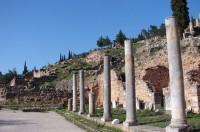
The Sacred Way
We are standing near the Main Entrance of the sanctuary facing west. To our right their are the ruins of a portico, dedicated by the Lacedaemonians for their victory at Aigos Potamoi. In the portico there stood the statues of the officials in command and loots from the battle. |
|
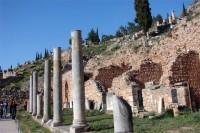
The Sacred Way |
|
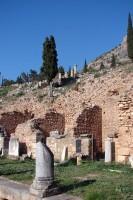
The Sacred Way |
|
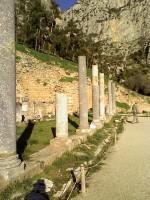
The Sacred Way
If we count carefully the pillars in this photo and the preceding 3 ones, we find ten pillars that supported a Stoa (Portico), offering dedicated by the Lacedaemonians after the battle of Aegospotamoi. It was close to the main entrance, as seen in the following photo of a model of the sanctuary. |
|
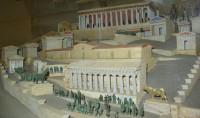
Delphi: Model of the Archaeological Site
In the front, flanked by bronze statues one can see the Sacred Way running past the Stoa (Portico) of the Lacedaemonians and heading to the Treasure of the Athenians (the small temple-like edifice facing us on the left of the photo). To the left of the prenamed portico, we can see a cemi-circular exhedra, with votive offerings of Argos (the King of Argos); on the top, the Temple of Apollo. |
|
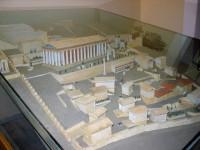
Delphi Model of the Archaeological Site (2nd century A.D.): General View
This model reproduces the Apollo Sanctuary as described by the 2nd century A.D. traveler, Pausanias. The Oracle is surrounded by ancient Wall, which is exactly above the main road. According to researchers, the ancient town used to be around it but it has not been adequately studied and thus, not included in this reproduction.
Positioning of the numerous important monuments in this model has been made according to the latest research on the Sanctuary. On both sides of the Holy road there are reproductions of the ancient well-known offerings, of which only the foundations exist today (Only one wooden offering was found in the sanctuary). |
|
Select Page of the Album:
|
|



